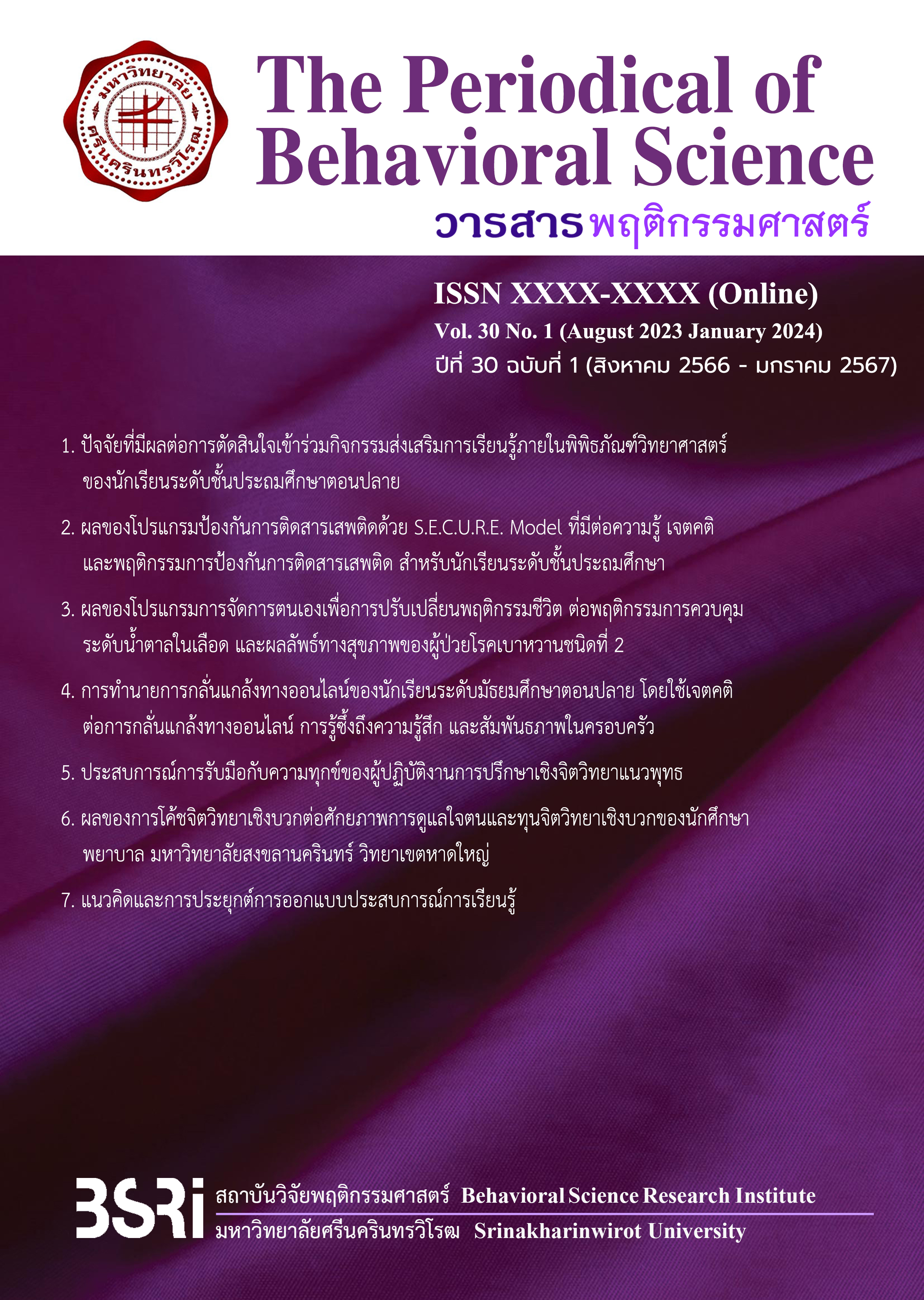การทำนายการกลั่นแกล้งทางออนไลน์ของนักเรียนระดับมัธยมศึกษาตอนปลาย โดยใช้เจตคติต่อการกลั่นแกล้งทางออนไลน์ การรู้ซึ้งถึงความรู้สึก และสัมพันธภาพในครอบครัว
คำสำคัญ:
การกลั่นแกล้งทางออนไลน์, เจตคติต่อการกลั่นแกล้งทางออนไลน์, การรู้ซึ้งถึงความรู้สึก, สัมพันธภาพในครอบครัวบทคัดย่อ
ในสังคมปัจจุบันมีการใช้สื่อสังคมออนไลน์กันอย่างแพร่หลาย ทำให้ยุคสมัยนี้สามารถติดต่อสื่อสารกันได้อย่างรวดเร็วและสะดวกสบาย แต่กระนั้นความสะดวกสบายก็มาพร้อมกับปัญหาในสังคมไทยที่เกิดขึ้น นั่นก็คือการกลั่นแกล้งทางออนไลน์ที่มีมากขึ้น ในการศึกษานี้มีวัตถุประสงค์ เพื่อศึกษาอิทธิพลของประสบการณ์ถูกกลั่นแกล้งทางออนไลน์ เจตคติต่อการกลั่นแกล้งทางออนไลน์ การรู้ซึ้งถึงความรู้สึก สัมพันธภาพในครอบครัว ที่มีต่อการกลั่นแกล้งทางออนไลน์ กลุ่มตัวอย่าง คือ นักเรียนระดับมัธยมศึกษาตอนปลายของโรงเรียนแห่งหนึ่งในจังหวัดสมุทรสาคร จำนวน 314 คน โดยเก็บรวบรวมข้อมูลด้วยแบบสอบถามทางออนไลน์ มีค่าความเชื่อมั่นอยู่ระหว่าง .68 - .91 ผลวิจัยพบว่า นักเรียนที่เคยมีประสบการณ์ถูกกลั่นแกล้งทางออนไลน์มีการกลั่นแกล้งทางออนไลน์สูงกว่านักเรียนที่ไม่เคยมีประสบการณ์ถูกกลั่นแกล้งทางออนไลน์ ( = .276, p < .001) เจตคติต่อการกลั่นแกล้งทางออนไลน์มีอิทธิพลทางบวกต่อการกลั่นแกล้งทางออนไลน์ ( = .146, p < .05) และการรู้ซึ้งถึงความรู้สึกมีอิทธิพลทางลบต่อการกลั่นแกล้งทางออนไลน์ (= -.275, p < .001) และสัมพันธภาพในครอบครัวไม่มีอิทธิพลต่อการกลั่นแกล้งทางออนไลน์ ( = -.056, p = .327) จากผลการศึกษาในครั้งนี้ สามารถนำมาปรับใช้เป็นข้อมูลเพื่อลดพฤติกรรมการกลั่นแกล้งทางออนไลน์ในนักเรียนมัธยมศึกษาตอนปลายต่อไป
Downloads
References
Ang, R. P., & Goh, D. H. (2010). Cyberbullying among adolescents: The role of affective and cognitive empathy, and gender. Child Psychiatry Hum Dev, 41(4), 387-397. https://doi.org/10.1007/s10578-010-0176-3
Aoyama, I., Barnard-Brak, L., & Talbert, T. L. (2011). Cyberbullying Among High School Students. International Journal of Cyber Behavior, Psychology and Learning, 1(1), 25-35. https://doi.org/10.4018/ijcbpl.2011010103
Bai, Q., Bai, S., Huang, Y., Hsueh, F.-H., & Wang, P. (2020). Family incivility and cyberbullying in adolescence: A moderated mediation model. Computers in Human Behavior, 110. https://doi.org/10.1016/j.chb.2020.106315
Baldry, A. C., Farrington, D. P., & Sorrentino, A. (2015). Am I at risk of cyberbullying? A narrative review and conceptual framework for research on risk of cyberbullying and cybervictimization: The risk and needs assessment approach. Aggression and Violent Behavior, 23, 36-51. https://doi.org/10.1016/j.avb.2015.05.014
Barlett, C., Chamberlin, K., & Witkower, Z. (2017). Predicting cyberbullying perpetration in emerging adults: A theoretical test of the Barlett Gentile Cyberbullying Model. Aggress Behav, 43(2), 147-154. https://doi.org/10.1002/ab.21670
Brewer, G., & Kerslake, J. (2015). Cyberbullying, self-esteem, empathy and loneliness. Computers in Human Behavior, 48, 255-260. https://doi.org/10.1016/j.chb.2015.01.073
Chan, K. L. (2017). Family Polyvictimization and Elevated Levels of Addiction and Psychopathology Among Parents in a Chinese Household Sample. J Interpers Violence, 32(16), 2433-2452. https://doi.org/10.1177/0886260515592617
Chen, Q., Lo, C. K. M., Zhu, Y., Cheung, A., Chan, K. L., & Ip, P. (2018). Family poly-victimization and cyberbullying among adolescents in a Chinese school sample. Child Abuse Negl, 77, 180-187. https://doi.org/10.1016/j.chiabu.2018.01.015
Davis, M. H. (1983). Measuring individual differences in empathy: Evidence for a multidimensional approach. Journal of Personality and Social Psychology, 44(1), 113-126. https://doi.org/10.1037/0022-3514.44.1.113
Fanti, K. A., Demetriou, A. G., & Hawa, V. V. (2012). A longitudinal study of cyberbullying: Examining riskand protective factors. European Journal of Developmental Psychology, 9(2), 168-181. https://doi.org/10.1080/17405629.2011.643169
Fok, C. C., Allen, J., Henry, D., & People Awakening Team. (2014). The brief family relationship scale: A brief measure of the relationship dimension in family functioning. Assessment, 21(1), 67-72. https://doi.org/10.1177/1073191111425856
Hinduja, S., & Patchin, J. W. (2010). Bullying, cyberbullying, and sui- cide. Archives of Suicide Research, 14, 206–221.
Lohaphatthanabamrung, A. (2022, March). Mood Swings in Teenagers. Department of Mental Health. https://dmh.go.th/news/view.asp?id=2504
Jansen, P. W., Verlinden, M., Dommisse-van Berkel, A., Mieloo, C., van der Ende, J., Veenstra, R., Varchulst, F. C., Jansen, W., & Tiemeier, H. (2012). Prevalence of bullying and victimization among children in early elementary school: Do family and school neighbourhood socioeconomic status matter? BMC Public Health, 12, 494. https://doi.org/10.1186/1471-2458-12-494
Jolliffe, D., & Farrington, D. P. (2006). Development and validation of the Basic Empathy Scale. J Adolesc, 29(4), 589-611. https://doi.org/10.1016/j.adolescence.2005.08.010
Manager Online. (2019, November). 5 Causes of Quarrels among Adolescents. MGROnline. https://mgronline.com/qol/detail/9620000109048
Post Today. (2019, October). Stop Bullying. Post Today. https://www.posttoday.com/lifestyle/603557
Rosenberg, M. J. (1960). Attitude organization and change: An analysis of consistency among attitude components (Vol. 3). Yale University Press.
Smith, P. K., Mahdavi, J., Carvalho, M., Fisher, S., Russell, S., & Tippett, N. (2008). Cyberbullying: Its nature and impact in secondary school pupils. J Child Psychol Psychiatry, 49(4), 376-385. https://doi.org/10.1111/j.1469-7610.2007.01846.x
Shim, H., & Shin, E. (2016). Peer-group pressure as a moderator of the relationship between attitude toward cyberbullying and cyberbullying behaviors on mobile instant messengers. Telematics and Informatics, 33(1), 17-24. https://doi.org/10.1016/j.tele.2015.06.002
Steffgen, G., Konig, A., Pfetsch, J., & Melzer, A. (2011). Are cyberbullies less empathic? Adolescents' cyberbullying behavior and empathic responsiveness. Cyberpsychol Behav Soc Netw, 14(11), 643-648. https://doi.org/10.1089/cyber.2010.0445
Tokunaga, R. S. (2010). Following you home from school: A critical review and synthesis of research on cyberbullying victimization. Computers in Human Behavior, 26(3), 277-287. https://doi.org/10.1016/j.chb.2009.11.014
Tudkuea, T., & Laeheem, K. (2014). Development of Indicators of Cyberbullying among Youths in Songkhla Province. Asian Social Science, 10(14). https://doi.org/10.5539/ass.v10n14p74
Udris, R. (2015). Cyberbullying in Japan: An Exploratory Study. International Journal of Cyber Society and Education, 8(2), 59-80. https://doi.org/10.7903/ijcse.1382
Van Cleemput, K., Vandebosch, H., & Pabian, S. (2014). Personal characteristics and contextual factors that determine helping, joining in, and doing nothing when witnessing cyberbullying. Aggress Behav, 40(5), 383-396. https://doi.org/10.1002/ab.21534
Wade, A., & Beran, T. (2011). Cyberbullying: The New Era of Bullying. Canadian Journal of School Psychology, 26(1), 44-61. https://doi.org/10.1177/0829573510396318
Wang, J., Iannotti, R. J., & Luk, J. W. (2012). Patterns of adolescent bullying behaviors: Physical, verbal, exclusion, rumor, and cyber. J Sch Psychol, 50(4), 521-534. https://doi.org/10.1016/j.jsp.2012.03.004
Willard, N. (2005). Educator’s Guide to Cyberbullying Addressing the Harm Caused by Outline Social Cruelty. http://cyberbully.or
Wright, M. F., Wachs, S., & Harper, B. D. (2018). The moderation of empathy in the longitudinal association between witnessing cyberbullying, depression, and anxiety. Cyberpsychology: Journal of Psychosocial Research on Cyberspace, 12(4), Article 6. https://doi.org/10.5817/cp2018-4-6
Osuwan, H. (2019). Factors Affecting Cyberbullying Behaviors of Lower Secondary School Students in Thailand [Master’s thesis, Chulalongkorn University]. Chulalongkorn University Intellectual Repository, https://cuir.car.chula.ac.th/handle/123456789/64771
Downloads
เผยแพร่แล้ว
How to Cite
ฉบับ
บท
License
Copyright (c) 2024 วารสารพฤติกรรมศาสตร์

This work is licensed under a Creative Commons Attribution-NonCommercial-NoDerivatives 4.0 International License.
สถาบันวิจัยพฤติกรรมศาสตร์ มหาวิทยาลัยศรีนครินทรวิโรฒ
114 ซอยสุขุมวิท 23 ถนนสุขุมวิท แขวงคลองเตยเหนือ เขตวัฒนา กรุงเทพฯ 10110
โทร 02-649-5000 ต่อ 17600


